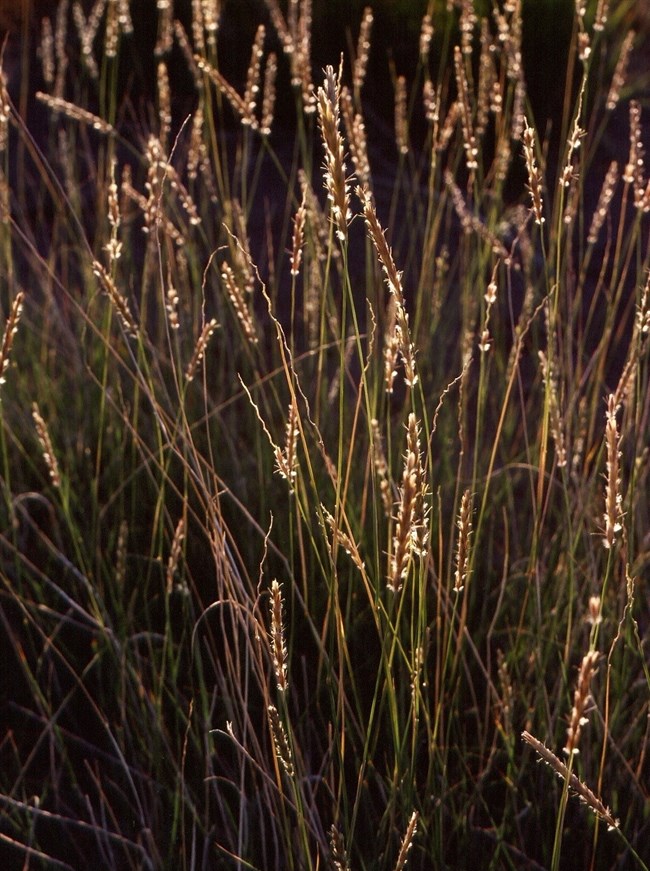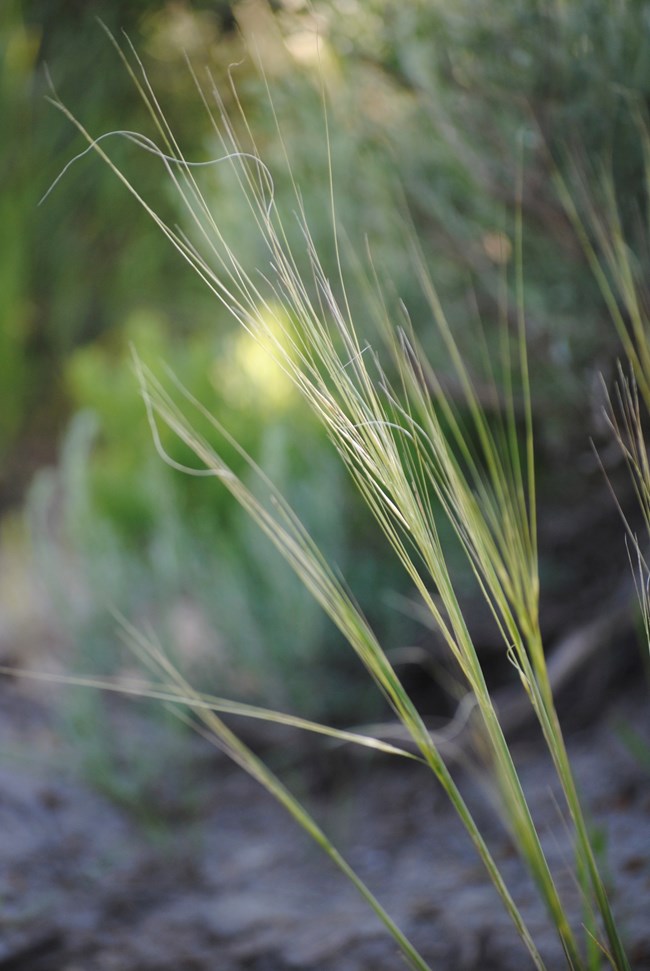|
Grasslands form in areas where wind-blown sediment and erosion have created a layer of soil that is several feet thick. Individual grasses sprout almost anywhere there is soil. Small grasslands form in potholes that have filled with dirt. Grasses found in Capitol Reef include bunch grasses and sod-forming grasses. Common bunch grasses in Capitol Reef include Indian ricegrass, needle-and-thread, and sand dropseed, while sod-forming grasses include blue grama grass and galleta grass. 
NPS Indian RicegrassScientific Name: Achnatherum hymenoides Description: Indian ricegrass is a perennial bunchgrass that starts growing rapidly in early spring and flowers in late spring. It stabilizes sandy soils which are susceptible to wind erosion, and therefore has been used for revegetating disturbed areas in Capitol Reef. Its black seeds are rich in protein and are an important food source for birds and small mammals. The seeds were also consumed by Native Americans, like the Fremont Culture, who collected and ground the seeds into meal using grinding stones (manos) and bowl-shaped rocks (metates). 
NPS Galleta GrassScientific Name: Hilaria jamesiiSize (height): 11–19 in (30–50 cm) tall Habitat: Grows at elevations between 3,500–7,500 feet (1,066–2286 m) where annual precipitation is 5–16 in (13–41 cm) Range: southern Wyoming and northern Nevada to southern California, northern Mexico, and southwestern Kansas. Description: Galleta is a perennial grass that flowers and produces seed in mid-summer, and is abundant in the park. It can withstand trampling by wildlife and is consumed by desert bighorn sheep. Its fuzzy flowers are clustered along the top 1–4 in (2.5–10 cm) of each stem. When its seeds ripen and fall, a distinctive zig-zap pattern is revealed along the upper stem. 
NPS / Laura Thomas Needle-and-Thread GrassScientific Name: Hesperostipa comata Description: Needle-and-thread grass is a perennial bunchgrass that starts growing in early spring. It is named for its sharp-pointed seed attached to a long twisted awn giving the appearance of a short needle and long thread. Once the seeds fall, the twisted awns unwind, driving the seeds into the soil like a corkscrew. Needle-and-thread grass is consumed by deer and elk in spring prior to awn development and again in fall after its seeds drop. If grazed by livestock or wildlife when seeds are ripe, the sharp seed may cause injury to the tongue, throat, eyes and ears. Needle-and-thread grass is very drought tolerant and is very effective in preventing wind erosion on sandy soils. Sand DropseedScientific Name: Sporobolus cryptandrus Size (height): 11–40 in (28–102 cm) Habitat: Grows at low elevation areas where annual precipitation is 5–15 in (13–38 cm). Range: Found throughout North America Description: Sand dropseed is a perennial bunchgrass that starts growing in spring. It produces many seeds which mature from June to August. The scientific name, Sporobolus, comes from the Greek words sporos and bolos which mean "seed" and "throw", referring to the seeds which fall or may be ejected when the fruit wall dries. This species produces a dense network of roots which can spread up to 2 ft (0.6 m) wide and over 8 ft (2.4 m) deep, making it extremely drought tolerant. This grass produces abundant seeds; a single inflorescence (cluster of flowers on one stem) is capable of producing 10,000 seeds! |
Last updated: February 14, 2021
